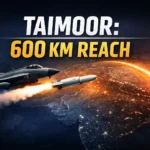In early 2025, the skies over South Asia witnessed a moment that could reshape regional air combat doctrines for years to come. Reports from defense circles suggest that a Pakistan Air Force (PAF) J-10C fighter jet successfully engaged and destroyed an Indian Air Force (IAF) Rafale at a staggering range of 182 kilometers using China’s advanced PL-15 beyond-visual-range air-to-air missile (BVRAAM).
If independently confirmed, this would mark the longest recorded air-to-air kill in South Asia, and one of the longest globally ushering in a new era where engagements are decided far beyond visual contact.
The Engagement: Precision at Extreme Range

According to sources familiar with the incident, the engagement occurred amid heightened cross-border patrols over Kashmir’s contested airspace.
Key elements of the reported encounter:
-
Detection Advantage – The PAF’s J-10C, equipped with an AESA radar, tracked the Rafale formation well before they were in visual range.
-
Networked Targeting – Real-time data from airborne early warning and control (AEW&C) platforms allowed the J-10C to maintain target lock without switching on its own radar until launch.
-
The Kill Shot – At approximately 182 km, a single PL-15 missile was fired, guided mid-course via datalink before activating its own seeker in the terminal phase, striking the Rafale before it could respond.
If accurate, this was not just a long-range interception—it was a textbook example of integrated network-centric warfare.
Weapon Focus: The PL-15
Developed by China’s Aviation Industry Corporation (AVIC), the PL-15 has been designed to counter top-tier Western air-to-air missiles like the AIM-120D and the Meteor.
Notable features include:
-
Range: Estimated 200–300 km under optimal conditions
-
Guidance: Active radar homing with mid-course datalink updates
-
ECM Resistance: Advanced counter-countermeasure capabilities
-
Propulsion: Long-burn solid-fuel motor for sustained speed
Deployed on the J-10C, the PL-15 allows Pakistan to engage threats before they can close in, effectively changing the engagement envelope in the IAF–PAF rivalry.
Rafale’s Image Put to the Test
The Rafale was inducted into the IAF between 2020 and 2022 as a flagship deterrent—touted as a “game changer” with Meteor missiles, cutting-edge avionics, and the Thales RBE2 AESA radar.
However, a confirmed kill at 182 km raises uncomfortable questions:
-
Did the Rafale fail to detect the incoming PL-15 in time?
-
Were its electronic warfare systems unable to jam or evade the missile?
-
Was it carrying the Meteor missile during the sortie, or operating in a configuration that reduced its air-to-air effectiveness?
While the Rafale remains a capable multirole fighter, this incident—if verified—shows that superiority on paper does not guarantee dominance in the air.
Strategic Implications for South Asia
-
Erosion of Indian BVR Superiority – For years, India held a perceived advantage in beyond-visual-range engagements, but the PL-15 changes that equation.
-
Validation of Chinese Tech – The incident gives credibility to Chinese missile design and may influence foreign buyers.
-
Tactical Reevaluation – IAF mission planning will likely shift toward avoiding deep incursions that expose aircraft to early interception.
-
Acceleration of the Arms Race – India may push harder for next-generation fighters (AMCA, MRFA program) and improved missile defense systems.
Pakistan’s Calculated Advantage
The J-10C, acquired from China in recent years, represents a cost-effective yet advanced multirole fighter solution. Its integration with the PL-15 gives Pakistan the ability to dictate engagement terms—a major strategic advantage in contested airspace.
This reflects not just hardware acquisition, but deep operational coordination between Pakistan and China, encompassing training, doctrine, and systems integration.
FAQs
Q: Is this the longest-range air-to-air kill in history?
If confirmed, it would be among the longest recorded in combat, certainly in South Asia.
Q: What makes the PL-15 so effective?
Its combination of extreme range, active radar guidance, and secure mid-course updates gives it a lethal engagement envelope.
Q: Could the Rafale have countered the attack?
Possibly, with early detection and the right loadout, but at 182 km, reaction time is extremely limited.
Conclusion
The reported downing of an IAF Rafale at 182 km is more than a tactical victory—it’s a signal that the future of aerial combat lies in sensor reach, missile range, and network integration.
For India, it’s a warning to reassess its doctrine and upgrade its long-range engagement capabilities. For Pakistan, it’s a validation of its investment in modern, networked warfare platforms.
Whether or not this specific engagement is fully confirmed by independent sources, the message is clear: the battle for air superiority in South Asia is now fought and often decided well beyond the horizon.









